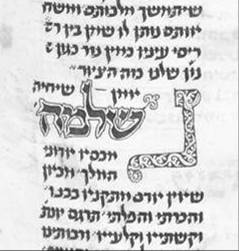Img. ID: 20439

© Bayerische Staatsbibliothek , Photographer: Unknown, 2008
Vol. I, fols. 74, 76v and 201v: Two pen drawings of the letter nun (nנ=; 5-7 lines) illustrate the commentary on Exodus and I Kings (Ex. 29:2; I Kings, 1:33-34). Both are inserted within the text column and preceded by the words "shaped as our nun like this" (,כזה fig. 1) and "like our nun in this drawing" (,כזה הציור fig. 3) respectively. The letters are decorated with spared-ground acanthus scrolls, one coloured red.
A third letter nun (Ex. 30:26-31, I:76v, 1st column) is small (1 line) and unadorned, preceded by the words "all the anointing like a nun" (כל המשיחות כמין נ, fig. 2).
 |
 |
 |
| Fig. 1: The letter nun, Munich Rashi's Commentary on the Bible, Munich, BSB Cod. hebr 5, I:74 | Fig. 2: The letter nun, Munich Rashi's Commentary on the Bible, Munich, BSB Cod. hebr 5,I:76v | Fig. 3: The letter nun, Munich Rashi's Commentary on the Bible, Munich, BSB Cod. hebr 5, I:201v |
Name/Title
Munich Rashi's Commentary on the Bible | Unknown
Object
Object Detail
Vol. I, fols. 74, 76v, 201v
Settings
Unknown
Date
1232/33
Synagogue active dates
Reconstruction dates
Artist/ Maker
Origin
Historical Origin
Unknown
Community type
Congregation
Unknown
Location
Site
Unknown
Period
Unknown
Period Detail
Collection
Germany | Munich | Bayerische Staatsbibliothek (BSB)
| Cod. hebr. 5/I-II (Steinschneider 1895, No. 5)
| Cod. hebr. 5/I-II (Steinschneider 1895, No. 5)
Documentation / Research project
Unknown
Category
Material / Technique
Brown ink and red.
Material Stucture
Material Decoration
Material Bonding
Material Inscription
Material Additions
Material Cloth
Material Lining
Tesserae Arrangement
Density
Colors
Construction material
Measurements
Height
Length
Width
Depth
Circumference
Thickness
Diameter
Weight
Axis
Panel Measurements
Subject
Condition
Extant
Documented by CJA
Surveyed by CJA
Present Usage
Present Usage Details
Condition of Building Fabric
Architectural Significance type
Historical significance: Event/Period
Historical significance: Collective Memory/Folklore
Historical significance: Person
Architectural Significance: Style
Architectural Significance: Artistic Decoration
Urban significance
Significance Rating
Textual Content
Unknown |
Languages of inscription
Unknown
Shape / Form
Unknown
0
Ornamentation
Custom
Contents
Codicology
Scribes
Script
Number of Lines
Ruling
Pricking
Quires
Catchwords
Hebrew Numeration
Blank Leaves
Direction/Location
Façade (main)
Endivances
Location of Torah Ark
Location of Apse
Location of Niche
Location of Reader's Desk
Location of Platform
Temp: Architecture Axis
Arrangement of Seats
Location of Women's Section
Direction Prayer
Direction Toward Jerusalem
Coin
Coin Series
Coin Ruler
Coin Year
Denomination
Signature
Colophon
Scribal Notes
Watermark
Hallmark
Group
Group
Group
Group
Group
Trade Mark
Binding
Decoration Program
Summary and Remarks
According to Rashi, the first case (fig. 1) refers to anointing the unleavened wafers: after baking they were tempered with oil as the Greek chaff which resembles the shape of our nun, like this (n-נ; Ex. 29:2; I:74, 3rd column: משחים בשמן. אחר אפייתן מושחן כמין כ"ף יונית שהיא עשוייה כנו"ן שלנו, כזה).
Rashi's commentary is based on BT Menahot 74b: "he took the oil with his finger like a Greek chi (χ)"; (for chi see Kasher 1992, addenda, Parashat Tetzaveh, vol. 23, parag. 20). This should illustrate the movement of the finger or hand while taking the oil from a vessel and spreading it on the wafers.
However, this does not explain the form of the Hebrew letter nun (נ), which resembles rather an inverted gamma (Γ). This error results from a conflation of two different traditions which appear in our commentary (Gruber 1994, pp. 31, 34 and n. 8). Rashi proceeds to explain the anointing of Aaron (Ex. 29:7): "even this anointing is like a Greek chaff, putting oil upon his head and between his eyelashes, joining them with his finger" (I:74, 3rd column: ומשחת אותו. אף משיחה זו כמין כ"ף יונית, נותן שמן על ראשו, ובין ריסי עיניו, ומחברן באצבעו).
In the second case (fig. 2), which refers to the anointing of the Tabernacle, the sanctuary implements and Aaron and his sons (Ex. 30:26), a smaller letter nun illustrates Rashi's emphasis that "all anointing was in the shape of the letter nun, except that of kings, which was like a diadem" (I:76v, 1st column ומשחת בו. כל המשיחות כמין כי יונית, חוץ משל מלכים שהן כמין נזר). However, in the third case (I Kings, 1:33-34) the shape of the letter nun (n-נ) illustrates the way Solomon was anointed with oil, apparently applied with a finger "between his eyelashes in the form of a diadem like our nun as in this drawing" (I:201v;נותן לו שמן בין ריסי עיניו כמן נזר, כגון נון שלנו, כזה הציור; fig. 3). This description too is a reflection of two traditions, which are explained in Rashi's commentary on Kritot 5b. There Rashi explains the difference between two kinds of anointing: that of kings "like a diadem: anointing round his head" and that of priests "like a chi: pour oil on his head and then between his eyelashes and combine them with the finger through the forehead" (Gruber 1994, p. 34, and fig.1).
To sum up, the three letters nun in our manuscript illustrate the movement of the finger or hand while "taking the oil" and applying it to a wafer or the eyelashes of priests and kings.
Remarks
Suggested Reconsdivuction
History/Provenance
Main Surveys & Excavations
Bibliography
Short Name
Full Name
Volume
Page
Type
Documenter
|
Author of description
|
Architectural Drawings
|
Computer Reconstruction
|
Section Head
|
Language Editor
|
Donor
|
Object Copyright
Bayerische Staatsbibliothek (BSB)
Negative/Photo. No.



